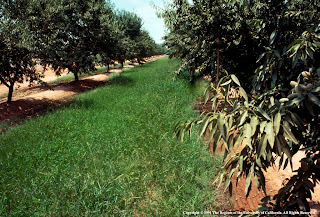Orchard Cover Cropping pt 1
Written by: Jessica Corcorran, Pomology Intern, UCCE Merced CountyJessica was selected by a committee to serve in the Summer Pomology Internship Program funded by the Almond Board of California. Being assigned within Merced County, she is working on several research projects, attending farm calls, and getting a feel for what it takes to be an extension agent. It is our hope that her career path will lead to extension work, hopefully serving the almond industry within California. She is entering her Senior Year at Cal Poly.
The use of orchard cover crops is not a new practice. The benefits of cover crops have long been recognized and have been widely used in agriculture. In recent years, cover crop use has increased due to a multitude of reasons which include soils health improvement, increased soil fertility, and increased water retention and penetration. In today’s post, I will cover the impacts of cover cropping on soil health. In subsequent posts, I will discuss other benefits of cover cropping, general pros and cons, as well as the practicalities of implementing a cover crop in an orchard.
Cover crops have the ability to greatly improve soil quality and structure. Water penetration is often compromised by soil compaction in orchard soils. The roots of the cover crop and their ability to move through the soil can help to reduce soil compaction by tillage and harvesting equipment. Plow pans have even shown to be corrected by the use of cover crops. The fibrous roots of the cover crop also help to stabilize soil aggregates, which improve soil structure and aids in effective water infiltration. The addition of organic matter in the soil invites beneficial microorganisms. During the breakdown of organic matter, indigestible compounds are formed that are resistant to decomposition. These compounds bind soil particles to form soil aggregates. Soil aggregates are important for improving water holding capacity and aeration.
Organic matter is often lacking in perennial agriculture systems. Typically, only through leaf abscission in the fall is organic matter returned to the soil. Cover crops can serve as “green manure”, meaning the plant matter is returned to the soil through tilling. This increases the amount of organic matter within the area tilled and the subsequent nutrient holding capacity of the soil zone. These nutrients will be available for later use by the trees. If a leguminous cover crop is used, nitrogen is naturally fixed in the soil and can reduce the amount of nitrogen fertilizer needed. Purple vetch or Lana vetch, for example, is shown to add 100 to 200 pounds of nitrogen per acre once it is tilled. The presence of microorganisms and earth worms is largely dependent on the amount of organic matter in the soil. By using a cover crop and building organic matter, increased population and activity of beneficial microorganisms and earth worms is often observed. Benefits of these organisms include soil buffering capacity, nutrient holding capacity, water infiltration, and soil aggregation.
Soil that is free of or lacking plant cover is very susceptible to soil erosion. The preservation and longevity of soil fertility is increased with the use of a cover crop. In the central valley, dust can be a problem, especially during periods of high wind and at harvest time. Implementing a cover crop reduces the soil’s exposure to wind and disruption by harvesting equipment. By not leaving the soil surface exposed, the occurrence of soil crusting and water runoff is also greatly reduced.

